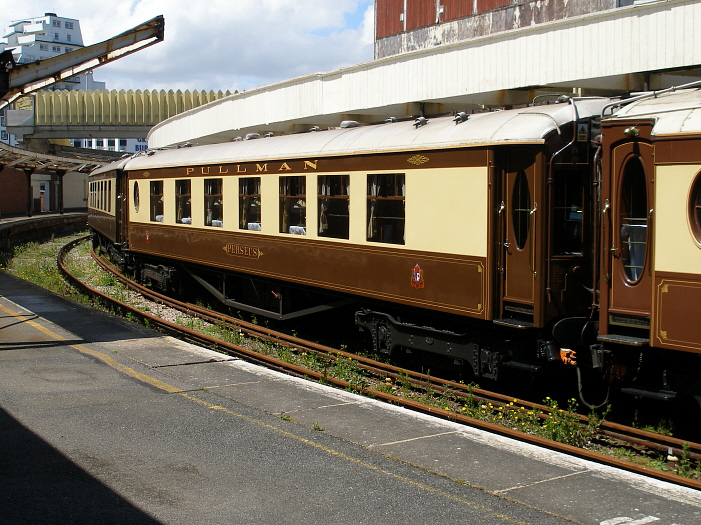
Perseus
Pullman Parlour First
Perseus was part of a production run of vehicles which, although originally ordered by the LNER from the Pullman Car Co. in 1938, took thirteen years to finally deliver. Materials for the task were accumulated by the contractor, the Birmingham Railway Carriage & Wagon Company, but the project ground to a halt on the declaration of war in September 1939 – construction had not even begun. By the end of the war, many Pullmans had been severely damaged by enemy action, and Preston Park Works, the Birmingham RC&W Co., and Metropolitan-Cammell, were engaged in an intensive repair and rebuild exercise. It was only after nationalisation that the LNER order of 1938 was fully realised: during 1951, a fleet of seven Pullman vehicles emerged from the works of the original contractor, but they were not bound for the Eastern Region.
· Aquila: Kitchen Car (Schedule No. 305)
· Carina: Kitchen Car (Schedule No. 307)
· Cygnus: Parlour Car (Schedule No. 308)
· Hercules: Parlour Car (Schedule No. 309)
· Orion: Kitchen Car (Schedule No. 306)
· Pegasus: The Trianon Bar: Bar Counter (Schedule No. 310)
· Perseus: Parlour Car (Schedule No. 301)
Livery: Pullman ‘’New Standard’’ Umber and Crème
The 1951 vehicles formed the celebratory ‘’Festival of Britain Golden Arrow’’ luxury train set, which commenced on 11th June of that year. There were detail differences between the 1951 batch and pre-war vehicles: the distinctive end lavatory windows were square with rounded corners, rather than the oval shape of the pre-war examples, and bogies were LNER Gresley-designed four-wheel sets, rather than the more common Pullman Standard variant. ‘’Perseus’’ remained a South Eastern Division vehicle for its entire career, although did perform a brief, but significant, role on the South Western Division: on 30th January 1965, it formed part of Sir Winston Churchill’s funeral train. During 1969, carriages of both Golden Arrow and Brighton Belle fleets began emerging from overhaul in the 1965-pioneered BR Blue and Grey livery, as applied to all ‘’main line’’ coaching stock. Names of Pullman vehicles were dispensed with in favour of the service names and schedule numbers, and ‘’Perseus’’ simply displayed No. S301S, complete with the text ‘’GOLDEN ARROW’’ on the lower body side. In the twilight years of the ‘’Golden Arrow’’ service, most of the Pullman vehicles were replaced by Second Class BR Mk 1 carriages, but No. S301S was fortunate in being retained until the end. The Golden Arrow’s last run was on 30th September 1972, and in the following year, No. S301S was purchased from British Rail by ‘’Scottish & Newcastle Breweries’’. Like sister coach ‘’Cygnus’’, No. S301S remained in store on Tyneside until 1976, when it briefly became a feature of the North Yorkshire Moors Railway. In the following year, it was purchased by the VSOE Company, and in 1979 arrived at the purpose-built VSOE workshop in Carnforth, Lancashire, for a complete rebuild. This included the replacement of the square-style lavatory windows with the oval variant of pre-war Pullmans, and asbestos removal, in addition to a complete rewire of the vehicle and the installation of Electric Train Heating (ETH). Being one of the earliest vehicles to be acquired by the VSOE company, it was completed in time to be displayed at London Victoria in November 1981, to commemorate the official launch of the VSOE British Pullman.
Tare (Empty Weight): 39 tons
Length: 63-foot 10-inches
Width: 8-foot 5½-inches
No. of Seats: 24 (increased to 32 during 1969 overhaul)
Bogies: LNER Gresley Four-Wheel
Route Availability (SR): 1
Construction: Timber frame, clad with steel sheeting
21st June 2007

Perseus retains its LNER Gresley-designed bogies, although has lost the square lavatory windows which were
fitted to those Pullmans built from 1951 onwards. The sparkling Pullman Parlour First makes a stark contrast
to the decaying surrounds of Folkestone Harbour. David Glasspool
Return to the Kent Rail Homepage or alternatively, check for Updates.
Website & Copyright information - Links - Contact the Webmaster
All content is copyright © David Glasspool